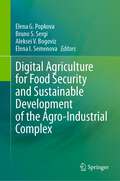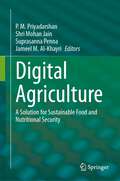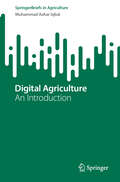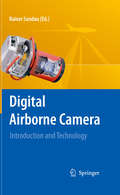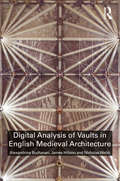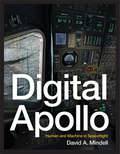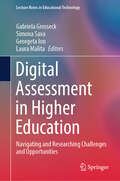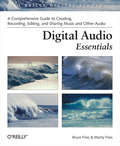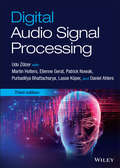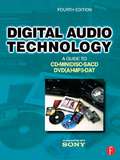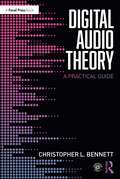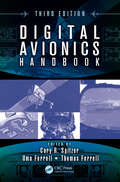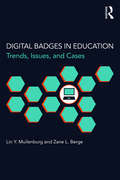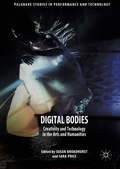- Table View
- List View
Digital Agriculture
by Aluízio Borém Daniel Marçal de Queiroz Domingos Sárvio M. Valente Francisco de Assis de Carvalho Pinto John K. SchuellerThis textbook addresses the most recent advances and main digital technologies used in farming. The reader will be able to understand the main concepts and techniques currently used to efficiently manage agricultural production systems. The book covers topics in a general and intuitive way, with examples and good illustrations.
Digital Agriculture for Food Security and Sustainable Development of the Agro-Industrial Complex
by Elena G. Popkova Aleksei V. Bogoviz Bruno S. Sergi Elena I. SemenovaThe book discusses the best international practices in digital agriculture. The book aims to form systemic scientific and methodological support and develop comprehensive applied solutions to unlock the potential of sustainable development of digital agriculture for food security. The book’s contribution to the literature lies in its comprehensive treatment of public and corporate management of farms representing digital agriculture. The research novelty is associated with the systemic disclosure of economic, legal, and technological issues in the development of digital agriculture. Thus, the book provides a solid foundation for integrating food security interests into farming practices. The first part of the book reflects the economic, legal, and technological support of quality management and sustainable development in digital agribusiness based on the best international practices. The second part focuses on Russian and international agricultural policies for food security. The book is intended for members of the academic community who will find promising solutions to current problems of food security through the development of digital agriculture. The book will also be of interest to farmers and representatives of the state regulation of the agricultural economy. In this book, they will find practical recommendations for improving government and corporate management of food security through the development of digital agriculture.
Digital Agriculture: A Solution for Sustainable Food and Nutritional Security
by P. M. Priyadarshan Shri Mohan Jain Jameel M. Al-Khayri Suprasanna PennaThe world population is increasing while arable land is decreasing at an alarming rate. About one-quarter of arable land is degraded and needs significant restoration before it can sustain crops again. By 2030, the water supply will fall 40% short of meeting global demand. Moreover, looming climate change poses additional challenge to increasing food production to feed 10 billion people by 2050. Current major agricultural systems are on a largely unsustainable trajectory because of their contributions to greenhouse gas emissions, water pollution, and biodiversity loss.For these reasons, innovative technologies are being introduced in modern agriculture to sustain food production. They include digital and geospatial technologies to manage soil, climate and plant genetic resources. With the development of tools and sensors integrated into the internet of things (IoT) environment, physically collected information is converted into computer-readable language. Digital innovations thus allow real-time analysis, machine learning, and artificial intelligence (AI) that manage massive amount of data, also known as big data. Accordingly, digital agriculture affords greater potential for sustainable farming and economic benefits. This book summarizes the latest advances in AI-integration of agriculture practices. Specific focus includes but not limited to, big data, yield mapping, pests management, and optimal fertigation. As such, it presents a forward-looking approach to meet multiple UN Sustainable Development Goals, specifically, SDG 2, 6, 13 and 15.
Digital Agriculture: An Introduction (SpringerBriefs in Agriculture)
by Muhammad Azhar IqbalThe success of modern-day agriculture lies in the digitalization of agricultural systems. The primary aim of this book is to provide a starting point to understand the fundamentals and design of digital agriculture systems with reference to the enabling technologies that deal with the production, improvement, and protection of crops/plants and livestock. The other associated objectives of this book include the explanation of the design and deployment of IoT-based digital agriculture systems in such a simple way that agriculture students understand straightforwardly. Therefore, this book is an effort to partially fill the gap associated with the understanding of the development and deployment of digital agriculture systems (including both precision and smart farming). We believe that with the provided details of enabling technologies and their usage in digital agriculture systems, agriculture students will find it easier to comprehend the designing of small-/large-scale IoT-based digital agriculture systems. This book provides insight into different technologies, architectures, and case studies that will ultimately help students to understand the concept of Digital Agriculture and its related applications. It enables students to realize the importance of open issues and future challenges of digital agriculture systems.
Digital Airborne Camera
by Rainer SandauDigital airborne cameras are now penetrating the fields of photogrammetry and remote sensing. Due to the last decade's results in research and development in the fields of for instance detector technology, computing power, memory capacity position and orientation measurement it is now possible to generate with this new generation of airborne cameras different sets of geometric and spectral data with high geometric and radiometric resolutions within a single flight. This is a decisive advantage as compared to film based airborne cameras. The linear characteristic of the opto-electronic converters is the basis for the transition from an imaging camera to an images generating measuring instrument. Because of the direct digital processing chain from the airborne camera to the data products there is no need for the processes of chemical film development and digitising the film information. Failure sources as well as investments and staff costs are avoided. But the effective use of this new technology requires the knowledge of the features of the image and information generation, its possibilities and its restrictions. This book describes all components of a digital airborne camera from the object to be imaged to the mass memory device. So the image quality influencing processes in nature are described, as for instance the reflection of the electromagnetic sun spectrum at the objects to be imaged and the influence of the atmosphere. Also, the essential features of the new digital sensor system, their characteristics and parameters, are addressed and put into the system context. The complexity of the cooperation of all camera components, as for instance optics, filters, detector elements, analogue and digital electronics, software and so forth, becomes transparent. The book includes also the description of example systems.
Digital Analysis of Vaults in English Medieval Architecture
by Nicholas Webb Alexandrina Buchanan James HillsonMedieval churches are one of the most remarkable creative and technical achievements in architectural history. The complex vaults spanning their vast interiors have fascinated both visitors and worshippers alike for over 900 years, prompting many to ask: ‘How did they do that?’ Yet very few original texts or drawings survive to explain the processes behind their design or construction. This book presents a ground-breaking new approach for analysing medieval vaulting using advanced digital technologies. Focusing on the intricately patterned rib vaulting of thirteenth and fourteenth century England, the authors re-examine a series of key sites within the history of Romanesque and Gothic Architecture, using extensive digital surveys to examine the geometries of the vaults and provide new insights into the design and construction practices of medieval masons. From the simple surfaces of eleventh-century groin vaults to the gravity-defying pendant vaults of the sixteenth century, they explore a wide range of questions including: How were medieval vaults conceived and constructed? How were ideas transferred between sites? What factors led to innovations? How can digital methods be used to enhance our understanding of medieval architectural design? Featuring over 200 high quality illustrations that bring the material and the methods used to life, Digital Analysis of Vaults in English Medieval Architecture is ideal reading for students, researchers and anyone with an interest in medieval architecture, construction history, architectural history and design, medieval geometry or digital heritage.
Digital Apollo
by David A. MindellAs Apollo 11's Lunar Module descended toward the moon under automatic control, aprogram alarm in the guidance computer's software nearly caused a mission abort. Neil Armstrongresponded by switching off the automatic mode and taking direct control. He stopped monitoring thecomputer and began flying the spacecraft, relying on skill to land it and earning praise for atriumph of human over machine. In Digital Apollo, engineer-historian David Mindell takes this famousmoment as a starting point for an exploration of the relationship between humans and computers inthe Apollo program. In each of the six Apollo landings, the astronaut in command seized control fromthe computer and landed with his hand on the stick. Mindell recounts the story of astronauts' desireto control their spacecraft in parallel with the history of the Apollo Guidance Computer. From theearly days of aviation through the birth of spaceflight, test pilots and astronauts sought to bemore than "spam in a can" despite the automatic controls, digital computers, and softwaredeveloped by engineers. Digital Apollo examines the design and execution of each of the six Apollomoon landings, drawing on transcripts and data telemetry from the flights, astronaut interviews, andNASA's extensive archives. Mindell's exploration of how human pilots and automated systems workedtogether to achieve the ultimate in flight--a lunar landing--traces and reframes the debate over thefuture of humans and automation in space. The results have implications for any venture in whichhuman roles seem threatened by automated systems, whether it is the work at our desktops or thefuture of exploration. David A. Mindell is Dibner Professor of the History of Engineering andManufacturing, Professor of Engineering Systems, and Director of the Program in Science, Technology,and Society at MIT. He is the author of Between Human and Machine: Feedback, Control, and Computingbefore Cybernetics and War, Technology, and Experience aboard the USS Monitor.
Digital Apollo: Human and Machine in Spaceflight (The\mit Press Ser.)
by David A. MindellHow human pilots and automated systems worked together to achieve the ultimate in flight—the lunar landings of NASA's Apollo program.As Apollo 11's Lunar Module descended toward the moon under automatic control, a program alarm in the guidance computer's software nearly caused a mission abort. Neil Armstrong responded by switching off the automatic mode and taking direct control. He stopped monitoring the computer and began flying the spacecraft, relying on skill to land it and earning praise for a triumph of human over machine. In Digital Apollo, engineer-historian David Mindell takes this famous moment as a starting point for an exploration of the relationship between humans and computers in the Apollo program. In each of the six Apollo landings, the astronaut in command seized control from the computer and landed with his hand on the stick. Mindell recounts the story of astronauts' desire to control their spacecraft in parallel with the history of the Apollo Guidance Computer. From the early days of aviation through the birth of spaceflight, test pilots and astronauts sought to be more than “spam in a can” despite the automatic controls, digital computers, and software developed by engineers.Digital Apollo examines the design and execution of each of the six Apollo moon landings, drawing on transcripts and data telemetry from the flights, astronaut interviews, and NASA's extensive archives. Mindell's exploration of how human pilots and automated systems worked together to achieve the ultimate in flight—a lunar landing—traces and reframes the debate over the future of humans and automation in space. The results have implications for any venture in which human roles seem threatened by automated systems, whether it is the work at our desktops or the future of exploration.
Digital Assessment in Higher Education: Navigating and Researching Challenges and Opportunities (Lecture Notes in Educational Technology)
by Gabriela Grosseck Simona Sava Georgeta Ion Laura MalitaThis book offers a comprehensive exploration of digital assessment (DA) in higher education, with a focus on navigating the challenges and opportunities brought on by the digital age. By drawing on research-based evidence and theoretical approaches, it offers valuable insights, guidance, and examples for navigating the complexities of DA in higher education. It addresses key topics and issues facing educators and Higher Education Institutions (HEIs) in the design, implementation, and evaluation of DA strategies, while also recognizing the importance of the DA competencies of academic staff. This book is a useful reference for educators, researchers, managers of HEIs, and policymakers who are looking to enhance digital assessment practices, develop their own competencies for digital assessments, and stay at the forefront of educational innovation.
Digital Audio Essentials: A comprehensive guide to creating, recording, editing, and sharing music and other audio
by Bruce Fries Marty FriesJoin the digital audio revolution! Tens of millions of users are embracing digital music, and with Digital Audio Essentials, you can, too. Nearly every personal computer built in the last few years contains a CD-burning drive; MP3 and other portable player sales dominate the consumer electronics industry; and new networkable stereo equipment lets you use your digital music collection to power your home entertainment system.Whether it's downloading music, ripping CDs, organizing, finding, and creating higher quality music files, buying music players and accessories, or constructing a home stereo system, Digital Audio Essentials helps you do get it done.An indispensable reference for music enthusiasts, digital archivists, amateur musicians, and anyone who likes a good groove, Digital Audio Essentials helps you avoid time-consuming, costly trial and error in downloading audio files, burning CDs, converting analog music to digital form, publishing music to and streaming from the Web, setting up home stereo configurations, and creating your own MP3 and other audio files. The book--for both Mac and PC users--includes reliable hardware and software recommendations, tutorials, resources, and file sharing, and it even explains the basics of the DMCA and intellectual property law.You may (or may not) already know the basics of ripping CDs or downloading music, but Fries will show you so much more--including advice on the multitude of MP3 players on the market, stereo options, file formats, quality determinations, and the legalities of it all. Both a timely, entertaining guide and an enduring reference, this is the digital audio handbook you need to make the most of your expanding digital music collection.
Digital Audio Signal Processing
by Udo ZölzerDigital Audio Signal Processing The fully revised new edition of the popular textbook, featuring additional MATLAB exercises and new algorithms for processing digital audio signals Digital Audio Signal Processing (DASP) techniques are used in a variety of applications, ranging from audio streaming and computer-generated music to real-time signal processing and virtual sound processing. Digital Audio Signal Processing provides clear and accessible coverage of the fundamental principles and practical applications of digital audio processing and coding. Throughout the book, the authors explain a wide range of basic audio processing techniques and highlight new directions for automatic tuning of different algorithms and discuss state- of-the-art DASP approaches. Now in its third edition, this popular guide is fully updated with the latest signal processing algorithms for audio processing. Entirely new chapters cover nonlinear processing, Machine Learning (ML) for audio applications, distortion, soft/hard clipping, overdrive, equalizers and delay effects, sampling and reconstruction, and more. Covers the fundamentals of quantization, filters, dynamic range control, room simulation, sampling rate conversion, and audio coding Describes DASP techniques, their theoretical foundations, and their practical applications Discusses modern studio technology, digital transmission systems, storage media, and home entertainment audio components Features a new introductory chapter and extensively revised content throughout Provides updated application examples and computer-based activities supported with MATLAB exercises and interactive JavaScript applets via an author-hosted companion website Balancing essential concepts and technological topics, Digital Audio Signal Processing, Third Edition remains the ideal textbook for advanced music technology and engineering students in audio signal processing courses. It is also an invaluable reference for audio engineers, hardware and software developers, and researchers in both academia and industry.
Digital Audio Technology: A Guide to CD, MiniDisc, SACD, DVD(A), MP3 and DAT
by Jan Maes Marc VercammenAn expert team from SONY Europe explains the technology behind today's major digital audio consumer products, including the Compact Disc, MiniDisc, Super Audio CD, DVD-Audio, MP3 and Digital Audio Tape. Beginning with a fascinating overview of the history of audio technology, this fourth edition addresses the principles and technologies which underpin the various formats currently available. Considerable technical detail is provided, with extensive use of illustrations to enhance understanding. Audio engineers, students and hi-fi enthusiasts who want to gain an understanding of the way these technologies have been developed will find no better introduction than this authoritative guide from SONY, a forerunner in the digital audio industry.
Digital Audio Theory: A Practical Guide
by Christopher L. BennettDigital Audio Theory: A Practical Guide bridges the fundamental concepts and equations of digital audio with their real-world implementation in an accessible introduction, with dozens of programming examples and projects. Starting with digital audio conversion, then segueing into filtering, and finally real-time spectral processing, Digital Audio Theory introduces the uninitiated reader to signal processing principles and techniques used in audio effects and virtual instruments that are found in digital audio workstations. Every chapter includes programming snippets for the reader to hear, explore, and experiment with digital audio concepts. Practical projects challenge the reader, providing hands-on experience in designing real-time audio effects, building FIR and IIR filters, applying noise reduction and feedback control, measuring impulse responses, software synthesis, and much more. Music technologists, recording engineers, and students of these fields will welcome Bennett’s approach, which targets readers with a background in music, sound, and recording. This guide is suitable for all levels of knowledge in mathematics, signals and systems, and linear circuits. Code for the programming examples and accompanying videos made by the author can be found on the companion website, DigitalAudioTheory.com.
Digital Avionics Handbook
by Cary R. Spitzer Uma Ferrell Thomas FerrellA perennial bestseller, the Digital Avionics Handbook offers a comprehensive view of avionics. Complete with case studies of avionics architectures as well as examples of modern systems flying on current military and civil aircraft, this Third Edition includes: Ten brand-new chapters covering new topics and emerging trends Significant restructuring to deliver a more coherent and cohesive story Updates to all existing chapters to reflect the latest software and technologies Featuring discussions of new data bus and display concepts involving retina scanning, speech interaction, and synthetic vision, the Digital Avionics Handbook, Third Edition provides practicing and aspiring electrical, aerospace, avionics, and control systems engineers with a pragmatic look at the present state of the art of avionics.
Digital Badges in Education: Trends, Issues, and Cases
by Zane L. Berge Lin Y. MuilenburgIn recent years, digital badging systems have become a credible means through which learners can establish portfolios and articulate knowledge and skills for both academic and professional settings. Digital Badges in Education provides the first comprehensive overview of this emerging tool. A digital badge is an online-based visual representation that uses detailed metadata to signify learners’ specific achievements and credentials in a variety of subjects across K-12 classrooms, higher education, and workplace learning. Focusing on learning design, assessment, and concrete cases in various contexts, this book explores the necessary components of badging systems, their functions and value, and the possible problems they face. These twenty-five chapters illustrate a range of successful applications of digital badges to address a broad spectrum of learning challenges and to help readers formulate solutions during the development of their digital badges learning projects.
Digital Bharat: डिजिटल भारत
by Dr Deepak Shikarpurपंचवीस वर्षांनी माहिती तंत्रज्ञानाची गंगा म्हणजेच 'आयटी' भारतात वाहत आहे आणि ती सर्वसामान्य नागरिकांसाठी वास्तव बनली आहे. अंगणी येऊन एक दशकाहून अधिक काळ लोटला आहे. मुळात ही संगणकीय क्रांती असली तरी, प्रत्येकाच्या हातात स्मार्टफोन (किमान साधे मोबाइल फोन) आल्यापासून त्याचा खरा प्रसार (आणि परिणाम) जाणवू लागला आहे. आपली बरीचशी सरकारी कामे ऑनलाइन होऊ लागली आहेत! किमान बिले भरणे, एखाद्या प्रकरणाची माहिती घेणे, तक्रारी दाखल करणे, संबंधित कार्यालयात पोहोचणे आणि तिथल्या विभागाचा शोध घेणे आणि योग्य अधिकाऱ्याची वाट पाहणे यासारख्या मूलभूत कामांसाठी शहरी-निमशहरी भागातही तासनतास वाया जातात. आणि जतन केलेले मानसिक आणि शारीरिक श्रम (सामाजिक, आर्थिक, आत्म-सुधारणा इ.) इतरत्र वापरा. काही हरकत नाही! आणि हे अगदी घरी केले जाऊ शकते. थोडे कौशल्य आत्मसात केले तर अनेकांना त्यात दूरगामी करिअरच्या (कमाईच्या) संधी मिळतील. इंटरनेट, कनेक्टेड कॉम्प्युटर किंवा स्मार्टफोन आणि स्वत:चे बँक खाते यांच्या मदतीने - अगदी गृहिणी देखील तिच्या घरातील आरामात पैसे कमवू शकते. एकदा तुम्ही डिजिटल कौशल्यांमध्ये प्रभुत्व मिळवल्यानंतर, तुम्ही अनेक व्यावहारिक, परस्पर पैलू हाताळण्यास सक्षम असाल. "खरीच कर लो दुनिया मुटका" हे स्वप्न आता सहज शक्य झाले आहे.
Digital Bodies
by Sara Price Susan BroadhurstThis book explores technologies related to bodily interaction and creativity from a multi-disciplinary perspective. By taking such an approach, the collection offers a comprehensive view of digital technology research that both extends our notions of the body and creativity through a digital lens, and informs of the role of technology in practices central to the arts and humanities. Crucially, Digital Bodies foregrounds creativity, the interrogation of technologies and the notion of embodiment within the various disciplines of art, design, performance and social science. In doing so, it explores a potential or virtual new sense of the embodied self. This book will appeal to academics, practitioners and those with an interest in not only how digital technologies affect the body, but also how they can enhance human creativity.
Digital Capital
by Sora ParkThis book describes and understands the many factors that influence a person's behavior towards digital technologies, and how that affects the person's potential to benefit from digital society. The ability to adapt to these new technological environments - and the extent to which an individual embraces them - has become critical to an individual's well-being and quality of life, the underlying assumption being that only by effectively engaging with digital technologies can the user accrue benefits from the experience. By introducing the concept "digital capital," which refers to the conditions that determine how people access, use, and engage with digital technology, Park examines how the digital ecosystem of the user lead to new forms of digital inequality. Using numerous empirical studies on internet users and non-users, as well as recommending small localized solutions to the big global problem, a critical and alternative perspective of the digital divide is provided.
Digital Capitalism: Networking the Global Market System
by Dan SchillerCyberspace not only exemplifies but spearheads the greater political economy of which it has become such a critical part. The networks that comprise cyberspace were originally created at the behest of government agencies, military contractors, and allied educational institutions. However, over the past generation or so, a growing number of these networks began to serve primarily corporate users. Under the sway of an expansionary market logic, the Internet began a political-economic transition toward what Dan Schiller calls "digital capitalism." Schiller traces these metamorphoses through three critically important and interlinked realms. Parts I and II deal with the overwhelmingly "neoliberal" or market-driven policies that influence and govern the telecommunications system and their empowerment of transnational corporations while at the same time exacerbating exisiting social inequalities. Part III shows how cyberspace offers uniquely supple instruments with which to cultivate and deepen consumerism on a transnational scale, especially among privileged groups. Finally, Part IV shows how digital capitalism has already overtaken education, placing it at the mercy of a proprietary market logic.
Digital Character Creation for Video Games and Collectibles
by Samuel KingThis book covers the process of creating digital characters for video games as well as for 3D printing and collectibles. It looks at character asset creation for high-end AAA console games as well as asset creation for legacy devices and the ever-growing mobile gaming industry. Lastly, it covers creation of figurines for 3D printing and collectibles. Digital Character Creation for Video Games and Collectibles provides a step-by-step walkthrough of creating these assets at an industry level standard. It includes the necessary theory that you need to understand how to be an effective character artist, but primarily focuses on the practical skills needed for creating character assets in the modern games and collectibles industries. This book will be of great interest to all beginners and junior character artists currently working in the gaming or collectible industry and for those looking to enter these industries. There is also relevant content in the highly detailed examples for people currently working in the industry and looking to pick up a few new tips, tricks and knowledge.
Digital Childhoods: Technologies And Children's Everyday Lives (International Perspectives on Early Childhood Education and Development #22)
by Marilyn Fleer Susan J. Danby Christina Davidson Maria HatzigianniThis book highlights the multiple ways that digital technologies are being used in everyday contexts at home and school, in communities, and across diverse activities, from play to web searching, to talking to family members who are far away. The book helps readers understand the diverse practices employed as children make connections with digital technologies in their everyday experiences. In addition, the book employs a framework that helps readers easily access major themes at a glance, and also showcases the diversity of ideas and theorisations that underpin the respective chapters. In this way, each chapter stands alone in making a specific contribution and, at the same time, makes explicit its connections to the broader themes of digital technologies in children’s everyday lives. The concept of digital childhood presented here goes beyond a sociological reading of the everyday lives of children and their families, and reflects the various contexts in which children engage, such as preschools and childcare centres.
Digital Circuit Boards
by Ralph MorrisonA unique, practical approach to the design of high-speed digital circuit boards<P><P> The demand for ever-faster digital circuit designs is beginning to render the circuit theory used by engineers ineffective. Digital Circuit Boards presents an alternative to the circuit theory approach, emphasizing energy flow rather than just signal interconnection to explain logic circuit behavior.<P> The book shows how treating design in terms of transmission lines will ensure that the logic will function, addressing both storage and movement of electrical energy on these lines. It covers transmission lines in all forms to illustrate how trace geometry defines where the signals can travel, then goes on to examine transmission lines as energy sources, the true nature of decoupling, types of resonances, ground bounce, cross talk, and more.<P> Providing designers with the tools they need to lay out digital circuit boards for fast logic and to get designs working the first time around, Digital Circuit Boards:<P> * Reviews in simple terms the basic physics necessary to understand fast logic design<P> * Debunks the idea that electrical conductors carry power and signals, showing that signal travels in the spaces, not the traces, of circuit boards<P> * Explains logic circuit behavior through real-time analysis involving the fields and waves that carry signal and energy<P> * Provides new information on how ground/power planes work<P> * Outlines a software program for solving energy flow in complex networks<P> Advisory: Bookshare has learned that this book offers only partial accessibility. We have kept it in the collection because it is useful for some of our members. To explore further access options with us, please contact us through the Book Quality link on the right sidebar. Benetech is actively working on projects to improve accessibility issues such as these.
Digital Circuits Laboratory Manual (Synthesis Lectures on Electrical Engineering)
by Farzin AsadiDigital systems are an important part of modern life. This book introduces the basic building blocks of digital systems and how these blocks can be used to design a digital system. It can be used as a laboratory manual for courses such as Digital Logic and Digital Electronics. All of the experiments in this book can be done in a simulation environment like: Proteus® or NI® MultiSim® or on the breadboard in a real laboratory environment.
Digital Circuits: Logic and Design
by Ronald C. EmeryThis textbook is intended to introduce the student of electronics to the fundamentals of digital circuits, both combinational and sequential, in a reasonable and systematic manner. It proceeds from basic logic concepts to circuits and designs.
Digital Cities: The Interdisciplinary Future of the Urban Geo-Humanities
by Benjamin FraserDigital Cities stakes claim to an interdisciplinary terrain where the humanities and social sciences combine with digital methods. Part I: Layers of the Interdisciplinary City converts a century of urban thinking into concise insights destined for digital application. Part II: Disciplinary/Digital Debates and the Urban Phenomenon delves into the bumpy history and uneven present landscape of interdisciplinary collaboration as they relate to digital urban projects. Part III: Toward a Theory of Digital Cities harnesses Henri Lefebvre's capacious urban thinking and articulation of urban 'levels' to showcase where 'deep maps' and 'thick mapping' might take us. Benjamin Fraser argues that while disciplinary frictions still condition the potential of digital projects, the nature of the urban phenomenon pushes us toward an interdisciplinary and digital future where the primacy of cities is assured.

